
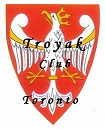
HAPPY NEW YEAR 2021
BONNE ANNÉE 2021

SZCZĘŚLIWEGO NOWEGO ROKU 2021
FELIZ AÑO NUEVO 2021
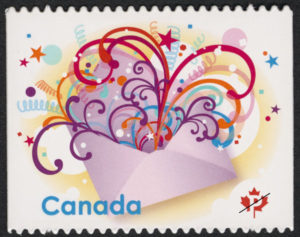
TROYAK EXECUTIVE TEAM is informing all members, colleagues, collectors, and Polonia at large, that Club meetings taking place at John Paul II Polish Cultural Centre, 4300 Cawthra Rd. (just south of Hwy. 403), Mississauga, Ontario. The new members are always welcome. www.polishculturalcentre.ca
ADRES SPOTKAÑ KLUBOWYCH ! Zarząd Główny Klubu “Troyak” informuje wszystkich członków kolekcjonerów, sympatyków oraz całą Polonię, że spotkania klubowe odbywają się w Polskim Centrum Kultury im. Jana Pawła II, przy 4300 Cawthra Rd. (na południe od autostrady 403), Mississauga, Ontario. Zapraszamy nowych członków do prężnego. Klubu “Troyak”. www.polishculturalcentre.ca

“TROYAK” CLUB NEXT MEETINGS …
NASTĘPNE SPOTKANIA KLUBU “TROYAK” …
17th January 2021 @ 4:30 p.m. … Annual General Meeting
31st January 2021 @ 4:30 p.m.
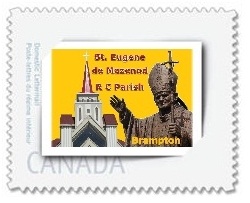
28th February 2021
7th March 2021 …
XVII Polish – Canadian Coin, Stamp & Collectibles Show 2021

28th March 2021
25th April 2021
30th May 2021; 27th June 2021

July & August 2021 – Summer break … Letnie wakacje …

TROYAK CLUB @ Roncesvalles Polish Festival 2021
Saturday, September 11th … Sunday, September 12th, 2021
https://polishfestival.ca www.kazimierz.org
26th September 2021

3rd October 2021 @ 9:00 a.m. to 4:00 p.m. …
Mississauga’s 5th Annual Fall Show
31st October 2021 @ 4:30 p.m.
28th November 2021
December 2021 @ Happy Holidays !

900 lat Kapituły Kolegiackiej w Głogowie
900 years of the Collegiate Chapter in Głogów
www.poczta-polska.pl
W piątek, 25 września 2020 r. Poczta Polska wprowadziła do obiegu znaczek pocztowy emisji „900 lat Kapituły Kolegiackiej w Głogowie”, wartość: 1 zł. Na znaczku w centralnym miejscu przedstawiono współczesny widok kolegiaty – będącej obecnie siedzibą parafii p.w. Wniebowzięcia Najświętszej Marii Maryi Panny w Głogowie, powstałej w miejscu wcześniejszej kościołów grodowych.
Kapitułę Kolegiacką w Głogowie ufundowano już w 1120 roku z inicjatywy księcia Bolesława Krzywoustego i biskupa wrocławskiego Heymo, dzięki czemu jest najstarszą siedzibą Kapituły Kolegiackiej na Śląsku. Po prawej stronie znaczka umieszczono posąg księżnej głogowskiej Salomei – żony księcia Konrada I, założyciela księstwa głogowskiego – z przełomu XIII i XIV wieku, obecnie w Muzeum Narodowym w Poznaniu. Oprócz znaczka Poczta Polska wydała, w limitowanej wersji, kopertę FDC, czyli kopertę wydawaną w pierwszym dniu obiegu znaczków. Widnieje na niej zdjęcie fragmentu kolegiaty – sklepienie krzyżowo-żebrowe widziane z perspektywy żaby z jednoczesnym widokiem na monumentalne filary świątyni. Autorka projektu: Agnieszka Sancewicz; liczba znaczków: 1; nakład: wielomilionowy, powtarzalny; technika druku: rotograwiura; format znaczka: 31,25 x 25,5 mm; papier: fluorescencyjny; arkusz sprzedażny: 100 znaczków.
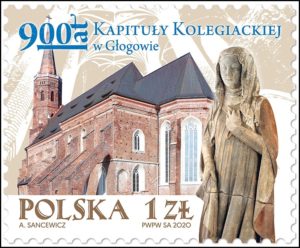
900 years of the Collegiate Chapter in Głogów …
denomination: 1,00 PLN; number of stamps in set: 1;
100 pcs. in sheet; printing techniques: photogravure;
print run: millions; stamp size: 31,25 x 25,5 mm;
paper: fluorescent; author: Agnieszka Sancewicz;
number of FDC: 1; circulation date: 25th September 2020.

„Świat oczami młodych”
World by the eyes of youths
www.poczta-polska.pl
Wartość: 3 x 3,30 zł … Autor projektu: Roch Stefaniak;
Liczba znaczków: 3; Nakład: po 90 000 sztuk każdego;
Technika druku: offset; Format znaczka: 51 x 39,5 mm;
Papier: fluorescencyjny; Formy sprzedaży: blok 3-znaczkowy;
Data obiegu: 28 września 2020 roku.
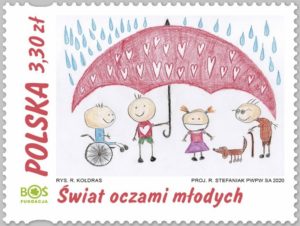
World by the eyes of youths … denomination: 3,30 PLN;
number of stamps in set: 3; print run: 90 000 pcs each;
printing techniques: offset; paper: fluorescent;
stamp size: 51 x 39,5mm; number of FDC: 1;
author: Roch Stefaniak; drawing authors: Robert Kołdrasa,
Anna Pietroń, Klaudia Peterko;
circulation date: 28th September 2020.
W poniedziałek, 28 września 2020 roku, Poczta Polska wprowadziła do obiegu znaczki pocztowe emisji „Świat Oczami Młodych”. Roch Stefaniak, autor projektu przedstawił na znaczkach trzy prace plastyczne, które otrzymały nagrody główne w konkursie „Świat Oczami Młodych”.
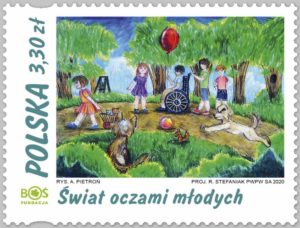
W czerwcu zakończyła się 4. edycja konkursu plastycznego „Świat oczami młodych”. Konkurs dla młodych artystów to inicjatywa Poczty Polskiej oraz Fundacji Banku Ochrony Środowiska. Tegoroczna edycja konkursu miała specjalny wymiar, ponieważ zorganizowana została w tak trudnym dla nas wszystkich czasie. Nie ograniczyło to jednak zainteresowania rywalizacją – prace zgłosiło ponad 800 osób. Nagrody główne trafiły do zwycięzców konkursu w poszczególnych kategoriach: Roberta Kołdrasa z Młodzieżowego Domu Kultury „Dom Harcerza” (kategoria poniżej 12 lat), Anny Pietroń ze Szkoły Podstawowej nr 2 w Rawie Mazowieckiej (kategoria 12–15 lat) oraz Klaudii Peterko z II Liceum Ogólnokształcącego w Rybniku (kategoria 16–19 lat).
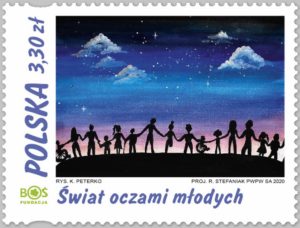
W konkursie plastycznym na projekt znaczka pocztowego „Świat oczami młodych” co roku poruszane są ważne społecznie tematy. Konkurs nie tylko edukuje młodzież w wybranych sprawach, ale stwarza jej możliwość wypowiedzi i dyskusji. Czwarta edycja konkursu organizowana pod hasłem „Wolontariat” poświęcona jest tematyce wolontariatu w różnych jego aspektach tj.: idee jakie za sobą niesie, przykłady działań wolontariackich, a także korzyści zarówno dla beneficjentów, jak i samych wolontariuszy.
Konkurs „Świat oczami młodych” to jedyna w swoim rodzaju możliwość samodzielnego zaprojektowania znaczka przez młodzież. Trzy najlepsze projekty wraz z nazwiskami ich autorów znajdą się na walorach wydanych przez Pocztę Polską we wrześniu tego roku w nakładzie 100 tys. egzemplarzy. Będą one dostępne w sklepie internetowym i sklepach filatelistycznych na terenie całego kraju.v Patronat honorowy nad konkursem objęli: Minister Edukacji Narodowej, Minister Infrastruktury, Ministerstwo Kultury i Dziedzictwa Narodowego, Ministerstwo Rodziny, Pracy i Polityki Społecznej oraz Rzecznik Praw Dziecka.

100. Rocznica Bitwy Niemeńskiej
100th Anniversary of the Battle over the Niemno
www.poczta-polska.pl
Dnia 28 września 2020 r. została wprowadzona do obiegu kartka pocztowa z nadrukowanym znakiem opłaty pocztowej, emisji: 100. rocznica Bitwy Niemeńskiej. Wartość nominalna znaku opłaty pocztowej z oznaczeniem literowym A odpowiada wartości nominalnej znaczka pocztowego używanego do uiszczenia opłaty za ekonomiczną przesyłkę listową nierejestrowaną, w tym kartkę pocztową, w obrocie krajowym, w formacie S o masie do 500 g. W prawym górnym rogu strony adresowej kartki nadrukowano znak opłaty pocztowej, na którym przedstawiono zdjęcie Józefa Piłsudskiego rozmawiającego z generałem Edwardem Śmigłym-Rydzem. Wzdłuż prawej krawędzi znaczka umieszczono napis: POLSKA, natomiast w lewym dolnym rogu – oznaczenie wartości: A. W części ilustracyjnej kartki znajduje się fotografia ,,Kawaleria polska w marszu na Lidę” z 1920 r. Kartki o wymiarach 148 x 105 mm wydrukowano jednostronnie, techniką offsetową, na kartonie białym, w nakładzie 8000 sztuk. Autor projektu kartki: Roch Stefaniak.
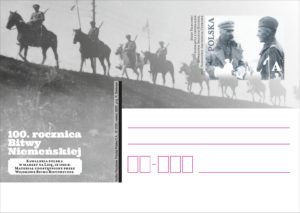
100th Anniversary of the Battle over the Niemno …
denomination: 3,30 PLN; number of stationeries in set: 1;
print run: 8.000 pcs; printing technique: offset;
card size: 148 x 105 mm; author: Roch Stefaniak;
release date: 28th September 2020.

Polski Zielnik
Polish Herbarium
www.poczta-polska.pl
W dniu 30 września 2020 zostały wprowadzone do obiegu 4 znaczki pocztowe o wartości 3,30 zł każdy, emisji “Polski Zielnik”. Na znaczkach umieszczono zioła: *** dziurawiec zwyczajny – Hypericum perforatum L. *** pokrzywa zwyczajna – Urtica dioica L. *** skrzyp polny – Equisetum arvense L. *** kozłek lekarski – Valeriana officinalis. Znaczki wydrukowano techniką offsetową, na papierze fluorescencyjnym, format znaczka: 40,5 x 40,5 mm, w nakładzie 90.000 szt. każdego. Arkusz sprzedażny zawiera 4 szt. znaczków. Z tej okazji zostały wydane dwie koperty FDC. Autor projektu znaczka: Agnieszka Sancewicz.
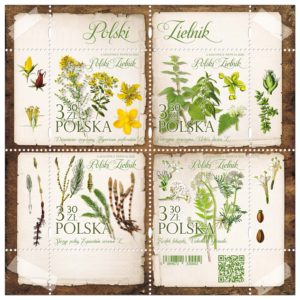
Polish Herbarium … denomination: 3,30 PLN each;
number of stamps in set: 4; print run: 90 000 pcs each;
printing techniques: offset; paper: fluorescent;
stamp size: 40,5 x 40,5 mm; number of FDC: 3;
author: Agnieszka Sancewicz;
circulation date: 30th September 2020.

Kolegiata Stargard – Klejnot Pomorza Zachodniego
Stargard Collegiate Church – The Jewel of Western Pomerania
www.poczta-polska.pl
Dnia 07 października 2020 r. został wprowadzony do obiegu znaczek pocztowy o wartości 4,00 zł emisji “Kolegiata Stargard – Klejnot Pomorza Zachodniego”. Na znaczku przedstawiono fragment zdjęcia ukazujący część ołtarza, filary boczne oraz część sklepienia Kolegiaty NMP Królowej Świata w Stargardzie. Wzdłuż dolnej krawędzi umieszczono napis ,,POLSKA” oraz oznaczenie wartości ,,4 zł”, a także napis ,,Kolegiata Stargard – Klejnot Pomorza Zachodniego”. Znaczek wydrukowano techniką rotograwiurową, na papierze fluorescencyjnym, w formacie znaczka: 25,5 mm x 31,25 mm, w nakładzie 4 000 000 sztuk. Arkusz zawiera 100 szt. znaczków. Z tej okazji została wydana również koperta FDC. Autor projektu znaczka: Poczta Polska S.A.
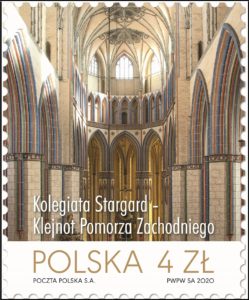
Stargard Collegiate Church – The Jewel of Western Pomerania …
denomination: 4,00 PLN; number of stamps in set: 1;
100 pcs. in sheet; printing techniques: photogravure;
print run: 4 000 000 pcs.; stamp size: 25,5 mm x 31,25 mm;
paper: fluorescent; author: Poczta Polska S.A;
number of FDC: 1; circulation date: 7th October 2020.

75. Rocznica powstania ONZ
75th Anniversary of the UN
www.poczta-polska.pl
Dnia 24 października 2020 r. został wprowadzony do obiegu znaczek pocztowy o wartości 3,30 zł emisji “75. rocznica powstania ONZ”. Na znaczku przedstawiono kulę ziemską i białego gołębia z gałązką laurową w dziobie. W dolnej części znaczka umieszczono logo obchodów 75. rocznicy powstania ONZ. Znaczek wydrukowano techniką rotograwiurową, na papierze fluorescencyjnym, w formacie: 31,25 x 39,5 mm, w nakładzie 120 000 sztuk. Arkusz zawiera 50 szt. znaczków. Z tej okazji została wydana również koperta FDC. Autor projektu znaczka: Jan Konarzewski.
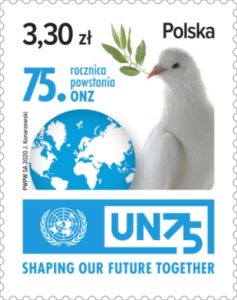
75th Anniversary of the UN … denomination: 3,30 PLN;
number of stamps in set: 1; 50 pcs. in sheet;
print run: 120 000; printing techniques: photogravure;
paper: fluorescent; stamp size: 31,25 x 39,5 mm;
number of FDC: 1; author: Jan Konarzewski;
circulation date: 24th October 2020.

Narodowy Bank Polski … Banknot 500 zł
www.nbp.pl
Narodowy Bank Polski … 10 lutego 2017 wprowadził do obiegu banknot o nominale 500 zł. Na banknocie o wartości nominalnej 500 zł znajduje się portret króla Jana III Sobieskiego. Na odwrotnej stronie znajduje się orzeł w koronie oraz pałac w Wilanowie.
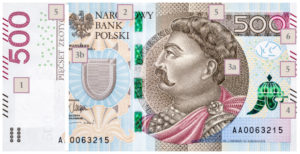
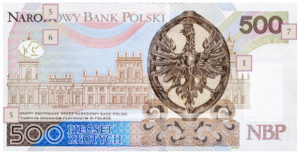
Charakterystyczne elementy banknotu o nominale 500 zł to: *** wymiary: 150 x 75 mm; *** znak wodny z cyfrowym oznaczeniem nominału widoczny pod światło na niezadrukowanym polu; *** nitka zabezpieczająca (okienkowa), której fragmenty są widoczne na powierzchni strony przedniej banknotu, w całości jest widoczna pod światło; *** korona w owalu, której pełny obraz tworzy się podczas oglądania banknotu pod światło; *** liczba „500” widoczna, w zależności od kąta patrzenia, w prawej części portretu władcy; *** szyszak husarski płynnie zmieniający barwę z zielonej na niebieską; *** wyczuwalne w dotyku elementy na stronie przedniej: portret władcy, podpisy Prezesa oraz Głównego Skarbnika NBP, godło Rzeczypospolitej Polskiej, napis „Warszawa” i data emisji, oznaczenie dla osób niewidomych w postaci dwóch pionowych linii złożonych z drobnych kwadratów oraz układu linii na krótszych krawędziach banknotu, napis „NARODOWY BANK POLSKI”, cyfrowe oznaczenie nominału, górny pas z prawej strony portretu. Na stronie odwrotnej: główny element szaty graficznej, słowne oznaczenie nominału, cyfrowe oznaczenie nominału, napis „NARODOWY BANK POLSKI”, klauzula prawna, pas u dołu banknotu.

On 10 February 2017, Narodowy Bank Polski issued into circulation the banknote with the face value of 500 zloty. The 500 zł banknote features a portrait of John III Sobieski. The reverse features an image of the eagle in a crown and the Royal Palace in Wilanów.


Characteristic elements of the banknote: *** banknote size: 150 x 75 mm; *** watermark showing the value numeral visible against the light in the field free from print; *** windowed security thread, whose fragments can be seen on the surface of the front of the banknote, while the whole security thread is visible when viewed against the light; *** crown in an oval, whose complete image becomes visible when the banknote is viewed against the light; *** value numeral “500”, depending on the angle at which the banknote is viewed, becomes visible on the right side of the portrait of the sovereign; *** lobster-tailed pot helmet smoothly changing colour from green to blue; *** elements on the front of the banknote which can be felt to the touch: portrait of the sovereign, signatures of the NBP President and the Chief Treasurer of NBP, emblem of the Republic of Poland, inscription “Warszawa” and the date of issue, features for the visually impaired in the form of two vertical lines composed of tiny squares and a composition of lines on the shorter edges of the banknote, inscription “NARODOWY BANK POLSKI”, denomination as a digital value numeral, stripe on the top-right side of the portrait. On the back of the banknote: the main graphic element, value numeral in words, value numeral “500”, inscription “NARODOWY BANK POLSKI”, legal clause, stripe at the bottom of the banknote.

Wielcy polscy ekonomiści – Leopold Caro
www.nbp.pl
Narodowy Bank Polski jest centralnym bankiem państwa odpowiadającym za politykę pieniężną i stabilność cen. Jego funkcje określa Konstytucja Rzeczypospolitej Polskiej i ustawa o NBP. NBP ma wyłączne prawo emisji pieniądza. Jako bank centralny nie prowadzi rachunków bankowych obywateli, nie przyjmuje od nich lokat, nie udziela kredytów. Prowadzi natomiast obsługę budżetu państwa, a także podmiotów sektora finansów publicznych. Gromadzi rezerwy walutowe państwa i zarządza nimi. Pełni funkcję banku banków, tworząc warunki do działania systemu bankowego. Jest również jednym z najważniejszych ośrodków naukowo-analitycznych w dziedzinie ekonomii i rynków finansowych. 14 października 2020 roku Narodowy Bank Polski wprowadził do obiegu srebrną monetę o nominale 10 zł z serii „Wielcy polscy ekonomiści” – „Leopold Caro”.
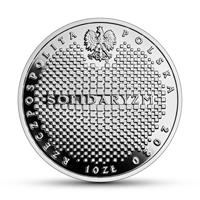
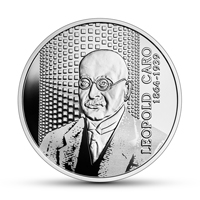
Nominał 10 zł … metal: Ag 925/1000; stempel: lustrzany; średnica: 32,00 mm; masa: 14,14 g; brzeg (bok): gładki; nakład: do 12 000 szt.; Projektant: Dominika Karpińska-Kopiec; Emitent: NBP; Na zlecenie NBP monetę wyprodukowała Mennica Polska S.A.
Leopold Caro (1864–1939) był jednym z najwybitniejszych przedstawicieli polskiego solidaryzmu katolickiego. Studiował na Uniwersytecie Lwowskim, gdzie uzyskał stopień doktora praw oraz absolutorium z filozofii. Następnie podjął studia ekonomiczne w Lipsku. Po powrocie do ojczyzny praktykował jako adwokat – początkowo we Lwowie, później zaś przeniósł swoją kancelarię do Krakowa. W 1914 r. został zmobilizowany do armii austriackiej, w której służył w czasie I wojny światowej. Po jej zakończeniu zaciągnął się na ochotnika do Wojska Polskiego. Zdemobilizowany w 1920 roku, osiadł na stałe we Lwowie. Objął katedrę ekonomii społecznej na Politechnice Lwowskiej. Przez krótki czas wykładał także na Uniwersytecie Jana Kazimierza. W 1927 r. został prezesem Polskiego Towarzystwa Ekonomicznego. W tym samym roku stał się członkiem Komisji Opiniodawczej przy Komitecie Ekonomicznym Rady Ministrów. W 1934 r. z inicjatywy kardynała Augusta Hlonda powołano do życia Radę Społeczną przy Prymasie Polski, w której Caro piastował stanowisko wiceprezesa. Zmarł we Lwowie w 1939 r. Leopold Caro inspirował się ideami francuskich teoretyków spółdzielczości oraz niemieckiej szkoły historycznej. Ujmował kwestie ekonomiczne w kontekście zasad katolickiej nauki społecznej, głosząc prymat etyki nad całością życia publicznego. Bliska mu była wizja społeczeństwa odzwierciedlająca współzależność ludzi i ich braterstwo.
W związku z tym wyznawał światopogląd solidarystyczny, stanowiący przeciwwagę zarówno dla kapitalizmu, jak i komunizmu – prądów propagujących przede wszystkim materialistyczną wizję człowieka. Solidaryzm postrzegał jako wizję porządku społecznego, w którym inicjatywa prywatna – oprócz interesu osobistego – uwzględnia także dobro publiczne. Głosił ideę sprawiedliwości społecznej rozumianej jako wyraz wspólnotowej troski o każdego człowieka. Niebagatelną w tym względzie rolę przypisywał państwu, które winno udzielać wsparcia osobom słabszym i bezbronnym. Do najważniejszych prac Caro należy zaliczyć następujące dzieła: Zasady nauki ekonomii społecznej, Solidaryzm. Jego zasady, dzieje i zastosowania, Zmierzch kapitalizmu, Problem społeczny w katolickim oświetleniu. Na awersie monety centralnie umieszczony został stylizowany napis: SOLIDARYZM. Na rewersie monety znajduje się wizerunek Leopolda Caro oraz daty jego urodzin i śmierci. Informacja: Grzegorz Jeż.

The Great Polish Economists – Leopold Caro
www.nbp.pl
Narodowy Bank Polski is the central bank of the State, responsible for its monetary policy and price stability. The Bank’s functions are described in the Constitution of the Republic of Poland and the Act on NBP. NBP holds the exclusive right to issue the currency of the Republic of Poland. As the central bank, it does not provide accounts for the general public, accept deposits from or extend loans to individuals. It acts as a banker to the State budget and public sector entities. NBP also holds and manages the foreign exchange reserves of the State. Finally, it functions as a banker to banks, creating conditions for the operation of the Polish banking system. Narodowy Bank Polski is one of the most important research and analytical centres in the fields of economics and financial markets. On 14 October 2020, Narodowy Bank Polski issued into circulation a silver coin of the series “The Great Polish Economists” – Leopold Caro, with a face value of 10 złoty.


Face value: 10 zł … Metal: Ag 925/1000; Finish: proof; Diameter: 32.00 mm; Weight: 14.14 g; Edge (side): plain; Mintage: up to 12,000 pcs; Designer: Dominika Karpińska – Kopiec; Issuer: NBP; The coins, commissioned by NBP, were struck by Mennica Polska S.A.
Leopold Caro (1864–1939) was one of the most outstanding representatives of Polish Catholic solidarism. He studied at the University of Lviv, where he was awarded the degree of Doctor of Laws and completed the philosophy study programme. Next, he took up economic studies in Lepizig. After his return to Poland, he practised as a lawyer – at first in Lviv, and later he moved his law firm to Cracow. In 1914, he was drafted into the Austrian army, where he served during World War I. When the war ended, he volunteered for the Polish Army. Demobilised in 1920, he settled permanently in Lviv. He took up the Chair of the Faculty of Social Economics at Lviv Polytechnic University. For a short time, he also lectured at the Jan Kazimierz University. In 1927, he was appointed Chairman of the Polish Economic Society. In the same year, he became a member of the Committee for opinion at the Economic Committee of the Council of Ministers. In 1934, on the initiative of Cardinal August Hlond, the Polish Primate’s Social Council was established, in which Caro held the position of its vice-chairman. He died in Lviv in 1939. Leopold Caro drew inspiration from the ideals developed by French theorists of cooperatives and the German historical school of economics. He put economic issues within the context of the principles of Catholic social teaching, propagating the primacy of ethics over the entire public sphere.
He embraced the vision of society reflecting people’s interdependence and brotherhood, and therefore held a worldview based on solidarity, as a counterweight to both capitalism and communism – trends propagating primarily the materialistic vision of man. He perceived solidarism as a vision of social order in which private initiative – apart from personal interest – also takes into account the collective public good. He promoted the idea of social justice understood as the expression of a community’s concern for every human being. In this respect, he assigned a substantial role to the state, which should provide support to the vulnerable and defenceless. The most important works by Caro include The Principles of Social Economic Science, Solidarism. Its Principles, History and Applications, The Twilight of Capitalism, The Social Problem in the Catholic View. The obverse of the coin features a stylised inscription in the centre: SOLIDARYZM [SOLIDARISM]. The reverse of the coin features the image of Leopold Caro and the dates of his birth and death. Info: Grzegorz Jeż.

Wyklęci przez komunistów żołnierze niezłomni
– Mieczysław Dziemieszkiewicz „Rój”
www.nbp.pl
Narodowy Bank Polski ma wyłączne prawo emitowania znaków pieniężnych Rzeczypospolitej Polskiej, w tym monet i banknotów kolekcjonerskich. Wszystkie monety i banknoty emitowane przez NBP są prawnym środkiem płatniczym w Polsce. Emisja wartości kolekcjonerskich stanowi okazję do upamiętniania ważnych historycznych rocznic i postaci. 3 listopada 2020 roku Narodowy Bank Polski wprowadził do obiegu srebrną monetę o nominale 10 zł z serii „Wyklęci przez komunistów żołnierze niezłomni” – „Mieczysław Dziemieszkiewicz »Rój«”.
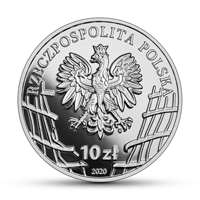
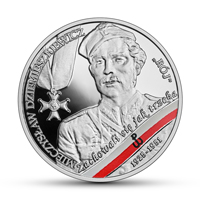
Nominał 10 zł … Metal: Ag 925/1000; Stempel: lustrzany, tampondruk; Średnica: 32,00 mm; Masa: 14,14 g; Brzeg (bok): gładki; Nakład: do 11 000 szt.; Projektant: Dobrochna Surajewska; Emitent: NBP. Na zlecenie NBP monety wyprodukowała Mennica Polska S.A.
Na awersie srebrnej monety przedstawiono rozerwane kraty więzienne. Na rewersie monety znajdują się wizerunki: Mieczysława Dziemieszkiewicza „Roja”, Orderu Odrodzenia Polski (Polonia Restituta), biało-czerwonej flagi z symbolem Polski Walczącej oraz napis: 1925–1951. Na każdej polskiej monecie znajdują się: nominał, napis „Rzeczpospolita Polska”, rok emisji, wizerunek orła ustalony dla godła Rzeczypospolitej Polskiej.
Mieczysław Dziemieszkiewicz, ps. „Rój” urodził się 25 stycznia 1925 r. w Zagrobach, w patriotycznej rodzinie, był synem Adama i Stefanii ze Świerczewskich. W 1939 r. ukończył szkołę powszechną w Różanie. Podczas niemieckiej okupacji, mimo młodego wieku, włączył się w działalność konspiracyjną Narodowych Sił Zbrojnych. Wiosną 1945 r. został wcielony do Ludowego Wojska Polskiego, ale zdezerterował na wiadomość o śmierci brata – por. Romana Dziemieszkiewicza, ps. „Pogoda”, zamordowanego w listopadzie 1945 r. przez sowieckich żołnierzy. Mieczysław Dziemieszkiewicz został żołnierzem XVI Okręgu Narodowego Zjednoczenia Wojskowego (Północne Mazowsze), przybierając pseudonim „Rój”. Od 1946 r. na terenie powiatu ciechanowskiego, w czasie masowych aresztowań dokonywanych przez bezpiekę, dowodził oddziałem Pogotowia Akcji Specjalnej NZW. Wkrótce za odwagę otrzymał Krzyż Walecznych.
W 1948 r. awansowany do stopnia starszego sierżanta. Przeprowadził kilkadziesiąt akcji przeciw funkcjonariuszom komunistycznej partii, aparatu terroru, agenturze. Brał także udział w rozbiciu ubeckiego więzienia w Pułtusku (25/26 listopada 1946 r.) i uwolnieniu 65 przetrzymywanych tam kolegów. 6 listopada 1949 r. w miejscowości Gołotczyzna nieopodal Ciechanowa zatrzymał pociąg osobowy, jego żołnierze rozdali antykomunistyczne ulotki, a sam dowódca wygłosił do pasażerów antysowieckie przemówienie. Edukacja podbijanego przez czerwonego okupanta społeczeństwa była jednym ze sposobów walki Mieczysława Dziemieszkiewicza. Żołnierze podziwiali jego głęboką religijność – każdy dzień zaczynał modlitwą; partyzanci z jego oddziału nosili ryngrafy z Matką Bożą. Tymczasem komunistyczna propaganda rozpowszechniała obraz „Roja” jako krwawego watażki, przypisując mu zbrodnie, których nigdy nie popełnił.
Do śmierci „Roja” przyczyniła się jego narzeczona, którą bezpieka – szantażując wyciągnięciem konsekwencji wobec rodziny – zmusiła do wskazania miejsca pobytu żołnierza. Otoczony w gospodarstwie Burkackich we wsi Szyszki sierżant Mieczysław Dziemieszkiewicz zginął 13 kwietnia 1951 r. podczas walki z 270-osobową grupą operacyjną UB i MO. Zwłoki „Roja” oprawcy pociągnęli za swoim samochodem. Do dziś nie udało się odnaleźć jego szczątków. Informacja: Tadeusz Płużański.

The Enduring Soldiers Accursed by the Communists
– Mieczysław Dziemieszkiewicz ‘Rój’
www.nbp.pl
Narodowy Bank Polski holds the exclusive right to issue the currency of the Republic of Poland, including collector coins and banknotes. All coins and banknotes issued by NBP are legal tenders in Poland. Issuing collector items is an occasion to commemorate important historic figures and anniversaries, as well as to develop the interest of the public in Polish culture, science, and tradition. All Polish coins feature: face value, an image of the Eagle established as the state emblem of the Republic of Poland inscription: Rzeczpospolita Polska, year of issue. On 3 November 2020, Narodowy Bank Polski issued into circulation a silver coin of the series “The Enduring Soldiers Accursed by the Communists” – Mieczysław Dziemieszkiewicz ’Rój’, with a face value of 10 złoty.


Face value 10 zł … Metal: Ag 925/1000; Finish: proof, pad printing; Diameter: 32.00 mm; Weight: 14.14 g; Edge (side): plain; Mintage: up to 11,000 pcs; Designer: Dobrochna Surajewska; Issuer: NBP. The coins, commissioned by NBP, were struck by Mennica Polska S.A.
The obverse of the silver coin features prison bars torn apart. The reverse of the coin features the images of Mieczysław Dziemieszkiewicz “Rój”, the Order of Polonia Restituta, a white-and-red flag with the Fighting Poland symbol, and the inscription: 1925–1951.
Mieczysław Dziemieszkiewicz, alias Rój, was born to a patriotic family in Zagroby on 25 January 1925. He was the son of Adam and Stefania, née Świerczewska. In 1939, he finished primary school in Różan. During the German occupation, young as he was, he engaged in the underground activity undertaken by the National Armed Forces. In the spring of 1945, he was drafted into the Polish People’s Army, but he deserted on hearing that his brother died – Lt. Roman Dziemieszkiewicz, alias Pogoda, was murdered by Soviet soldiers in November 1945. Mieczysław Dziemieszkiewicz enlisted as a soldier with the 16th District of the National Military Union (Northern Mazovia), adopting the pseudonym “Rój”. From 1946, at the time of mass arrests made by the secret police, he was in command of a detachment of the Special Action Unit of the National Military Union in the administrative district of Ciechanów. Soon, he was awarded the Cross of Valour for his bravery. In 1948, he was promoted to the rank of Senior Sergeant. He performed dozens of actions against the officials of the Communist Party, the officers of the terror apparatus, and secret police confidants. He was also involved in raiding the communist secret service prison in Pułtusk (25/26 November 1946) and releasing his sixty-five colleagues detained there.
On 6 November 1949, in the town of Gołotczyzna near Ciechanów, he stopped a passenger train – his soldiers handed out anti-communist leaflets, and the commander himself delivered an anti-Soviet speech. Educating the society conquered by the Soviet occupant was one of Mieczysław Dziemieszkiewicz’s ways of combat. Soldiers admired his deep religiousness – he started each day with a prayer and partisans of his detachment wore gorgets featuring the Mother of God. Meanwhile, the communist propaganda disseminated the image of “Rój” as a bloodthirsty warlord, imputing to him crimes he never committed. His death was brought about by his fiancée – the secret service blackmailed her into indicating the soldier’s whereabouts, threatening to make her family suffer the consequences if she wouldn’t. Surrounded in the household of the Burkacki family in the village of Szyszki, Sergeant Mieczysław Dziemieszkiewicz died in a fight against a 270-man strong joint operational group of the Department of Security and Citizens’ Militia on 13 April 1951. His murderers dragged his body behind their car. So far, no one has been able to locate his remains. Info: Tadeusz Płużański.


Mary Riter Hamilton: PermanentTM Domestic rate stamps
www.canadapost.ca
Celebrate Mary Riter Hamilton and her incredible work with this booklet of 10 PermanentTM domestic rate stamps, featuring a reproduction of her painting Trenches on the Somme (1919). Canada’s first unofficial woman battlefield artist, Mary Riter Hamilton spent two and a half years visiting battered landscapes in France and Belgium after the First World War. Producing more than 300 paintings, drawings and etchings, she captured the destruction caused by the conflict and the reconstruction efforts. Stamp Value: PermanentTM (domestic rate); Stamp Designer: Réjean Myette; Quantity Produced: 130,000; Dimensions: 36 mm x 36 mm; Issue Date: October 28, 2020.
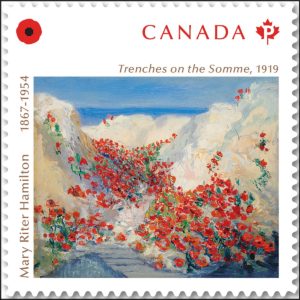
Mary Riter Hamilton: Official First Day Cover … Celebrate distinguished artist Mary Riter Hamilton with this Official First Day Cover, which features a detail of her painting Trenches on the Somme (1919). The stamp is cancelled in her hometown of Teeswater, Ontario. Commissioned by the Amputation Club of British Columbia to paint the battlefield landscapes in France and Belgium, Mary Riter Hamilton was Canada’s first unofficial woman battlefield artist. Over two and a half years, and in arduous conditions, she produced more than 300 paintings, drawings, and etchings, depicting scenes of destruction and reconstruction after the First World War.
Stamp Value: PermanentTM (domestic rate); Stamp Designer: Réjean Myette; Quantity Produced: 7,000; Dimensions: 190 mm x 112 mm; Issue Date: October 28, 2020.

2020 … $1 … 75th Anniversary of the Signing Of
The United Nations Charter
www.mint.ca
Allies in war became allies for peace. A promise the world must not forget. Peace. Tolerance. Equality. These are values we uphold today, as we did 75 years ago when the devastation of war gave way to a new era of cooperation. On the 75th anniversary of the United Nations (UN), Canada’s 2020 $1 circulation coin celebrates our nation’s role as a Founding Member and a contributor to world peace. Grouped together in a keepsake collector card, this seven-piece set includes both versions (uncoloured and coloured) of our special $1 coin commemorative circulation coin, which highlights our role as global citizens helping to make the world a better place. The set also includes one of each Canadian coin denomination issued in 2020. UN at 75: Celebrate Canada’s contributions to the United Nations with a commemorative $1 coin — two versions included in this set!
2020 … $1 … 75th Anniversary of the Signing Of The United Nations Charter Uncoloured Coin … Composition: three-ply brass-plated steel; Finish: circulation; Weight: 6.27 g; Diameter: 26.5 mm; Edge: plain; Artist: Joel Kimmel (reverse), Susanna Blunt (obverse).
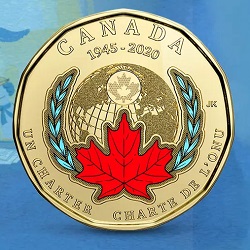
2020 … $1 … 75th Anniversary of the Signing Of The United Nations Charter Coloured Coin … Composition: three-ply brass-plated steel; Finish: circulation; Weight: 6.27 g; Diameter: 26.5 mm; Edge: plain; Artist: Joel Kimmel (reverse), Susanna Blunt (obverse).
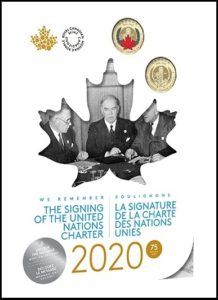
Design: The reverse design by Joel Kimmel is double-dated (“1945-2020”) to commemorate the 75th anniversary of the United Nations and its Charter (“UN CHARTER CHARTRE DE L’ONU”). In a nod to the UN logo, a world map within an olive branch wreath is paired with a maple leaf to symbolize Canada’s commitment to the UN and its values. In the selectively coloured $1 coin, the maple leaf is clad in red. Both versions include a laser mark of a single maple leaf inscribed in a circle. The obverse features the effigy of Her Majesty Queen Elizabeth II by Susanna Blunt.
Did you know… *** Canada remains committed to the principles outlined in the UN Charter. The Charter represents a pledge between the Member States to work together to resolve conflicts, promote development, champion human rights, and maintain peace. *** The first official use of the name “United Nations” appeared in the Declaration by United Nations signed on January 1, 1942. This precursor to the UN Charter, also known as the Atlantic Charter, was the product of a secret meeting at sea between President Franklin D. Roosevelt (United States) and Prime Minister Winston Churchill (United Kingdom). In fact, the meeting took place off the coast of Ship Harbour, N.L., in Placentia Bay.

2020 … Commemorative Collector Keepsake – Bill Reid
www.mint.ca
This six-piece circulation set gives you two different versions (struck and coloured) of the 2020 $2 Bill Reid Commemorative coin. These 2020 exclusives come packaged in a keepsake collector card alongside one of each classic circulation denomination issued this year: $1, 25-, 10- and 5-cent coins. The reverse design features Xhuwaji / Haida Grizzly Bear by renowned Haida artist Bill Reid on the inner core and extending onto the outer ring. It is a proud celebration of culture in Canada and a special tribute to the artist on the 100th anniversary of his birth.
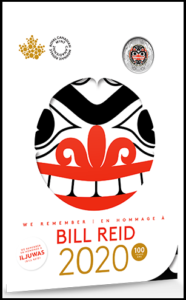
Face value: 2 dollars … Composition: Nickel-Plated Steel ($2);
Mintage: 100,000; Finish: Circulation; Diameter: 28 mm ($2);
Artist: Bill Reid ($2) (reverse), Susanna Blunt (obverse).
Haida artist Bill Reid’s contributions to the Haida Nation, and to Canada, through his art, have secured his place on our coins. This six-piece circulation set gives you two different versions (uncoloured and coloured) of the 2020 $2 Bill Reid Commemorative coin. These 2020 exclusives come packaged in a keepsake collector card alongside one of each classic circulation denomination issued this year: $1, 25-, 10- and 5-cent coins. It is a proud celebration of Haida art and culture and a special tribute to the artist on the 100th anniversary of his birth.
Did you know? … *** Between 2001 and 2006, Canada’s $20 banknote highlighted several works by Bill Reid, including Xhuwaji / Haida Grizzly Bear featured on this coin. If the banknote’s version looks different, it is — for security, technical and aesthetic reasons, the original colours were replaced by yellow and orange. *** The artwork featured on 2020 $2 coin originally appeared on a ceremonial drum, one of several designed by Bill Reid. Xhuwaji, Haida Grizzly Bear was adapted for reproduction as a silkscreen print, with copies sold to raise money for Artists for Kids. The original drum is part of the Artists for Kids permanent collection. *** Xuu.ajii (Grizzly Bear) was a favourite character of Bill Reid’s and he often used it in his jewellery designs and sculpture. Xuu.ajii is an important crest among the Haida Nation and plays a significant role in ancient Haida narratives. *** The Skidegate Haida spelling for Grizzly Bear has evolved since Reid created Xhuwaji, Haida Grizzly Bear. Today, the word for Grizzly Bear is spelled xuu.ajii. This is because, in recent decades, the spelling and phonetic structure of the Haida language have been refined through the efforts to revitalise the language by community members, particularly Elders, via the Skidegate Haida Immersion Program (SHIP).
Design … The reverse design features Xhuwaji / Haida Grizzly Bear by renowned Haida artist Bill Reid on the inner core and extending onto the outer ring. On the top portion of the outer ring, two images of a maple leaf appear within the line pattern. A banner at the bottom of the outer ring bears the inscriptions “BILL” and “REID” in honour of the 100th anniversary of the Haida artist’s birth, while “2020” is centred between two security marks that consist of a maple leaf within another maple leaf. The selectively coloured $2 coin features the same reverse design encircled by a ring and enhanced with colours of red, white, and black. Both versions feature the effigy of Her Majesty Queen Elizabeth II by Susanna Blunt on the obverse. The coin[s] feature[s] an adaptation of the following artwork by Bill Reid: Xhuwaji, Haida Grizzly Bear, 1990.
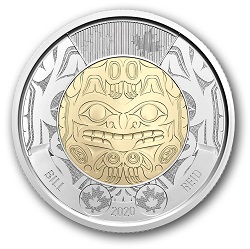
2020 … $2 Bill Reid Uncoloured Coin … Composition outer ring: three-ply nickel finish plated steel; inner core: three-ply brass finish plated aluminium bronze; Finish: circulation; Weight: 6.99 g; Diameter: 28 mm; Edge: interrupted serrations; Artist: Bill Reid (reverse), Susanna Blunt (obverse).
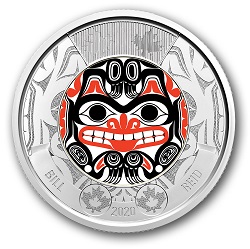
2020 … $2 Bill Reid Coloured Coin … Composition: outer ring: three-ply nickel finish plated steel; inner core: three-ply brass finish plated aluminium bronze; Finish: circulation; Weight: 6.99 g; Diameter: 28 mm; Edge: interrupted serrations; Artist: Bill Reid (reverse), Susanna Blunt (obverse).

2020 … $30 Pure Silver Coin –
Imposing Icons Series: Bighorn Sheep
www.mint.ca
Canada is a big, beautiful country filled with awe-inspiring sights—from imposing landscapes to rare sightings of animals that represent our untamed spirit. Our Imposing Icons series celebrates Canada’s rugged beauty by inviting you to get up close and personal with our wild animal icons. Splendidly engraved as a backdrop, the spaces they inhabit are every bit as captivating as our picture-perfect portrait of each species. And with a 50 mm diameter that allows plenty of room for a nose-to-muzzle meeting, these four coins might be your closest wildlife encounter yet!
This coin features a rare, front-facing image of the strapping bighorn. The wilderness in the background is every bit as breathtaking. From mountains to forests, the Canadian landscape is beautifully re-created thanks to finely detailed engraving, with multiple finishes to add an extra dimension. The strapping bighorn sheep is right at home in one of Canada’s most scenic, most photographed and perhaps most daunting landscapes. Other species might stick to lower elevations but this natural climber easily travels along the slopes of the Canadian Rockies, where it grazes in the valleys or ascends to heights that give it a commanding view.
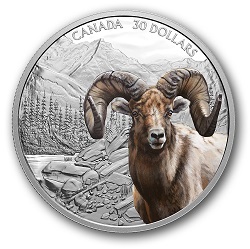
Face value: 30 dollars … Composition: 99.99% pure silver; Mintage: 2,500; Finish: proof; Weight: 62.69 g; Diameter: 50 mm; Edge: serrated; Certificate: serialized; Artist: Maurade Baynton (reverse), Susanna Blunt (obverse).
Design: Designed by artist Maurade Baynton, the reverse features a selectively coloured, close-up view of the Rocky Mountain bighorn sheep (Ovis canadensis). The finely engraved backdrop showcases the bighorn sheep’s natural habitat: the soaring peaks and breathtaking valleys of the Canadian Rockies. The obverse features the effigy of Her Majesty Queen Elizabeth II by Susanna Blunt. … “The bighorn sheep has broomed the tips of his fully curled horns—they typically break them off at eye level in order to see past them. You can see the scars on its face from battles previously waged.” Maurade Baynton: Artist.

2020 … $30 Pure Silver Coin –
Imposing Icons Series: Moose
www.mint.ca
Get up close and personal with Canada’s wild animal icons with this pure silver coin featuring the majestic moose. The second in the four-part Imposing Icons series, this coin’s 50 mm diameter allows plenty of room for a selectively coloured nose-to-muzzle meeting in an engraved natural setting. The selective colour instantly draws the eye towards the wildlife, but the wilderness in the background is every bit as breathtaking. From mountains to forests, the Canadian landscape is beautifully re-created thanks to finely detailed engraving, with multiple finishes to add an extra dimension. This might be your closest encounter with the reclusive moose!
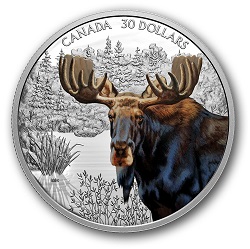
Face value: 30 dollars … Composition: 99.99% pure silver; Mintage: 2,500; Finish: proof; Weight: 62.69 g; Diameter: 50 mm; Edge: serrated; Certificate: serialized; Artist: Maurade Baynton (reverse), Susanna Blunt (obverse).
Design: Designed by artist Maurade Baynton, the reverse features a selectively coloured, close-up view of the moose (Alces alces). The finely engraved backdrop showcases the moose’s natural habitat: the boreal forest that stretches across Canada. The obverse features the effigy of Her Majesty Queen Elizabeth II by Susanna Blunt. … “The moose is a massive animal that can’t be appreciated until seen in real life. This bull moose is growing out his antlers, which are in the velvet stage. Once these have finished growing, the velvet will be shed and the points sharpened as it readies for battle.” Maurade Baynton: Artist.
Did you know… *** Just like us, the moose loves to cool off in the water on a hot summer day. It’s been known to swim a distance of 19 kilometres and dive more than 5.5 metres deep to munch on aquatic plants. *** Sorry caribou, the moose is taller than you—a bull can weigh up to 700 kg and stand 2 metres tall at the shoulder. In Canada, the moose is the largest member of the deer family. *** Unlike the bighorn sheep, the moose sheds and re-grows its antlers annually.



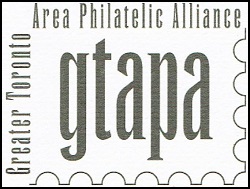
www.gtapa.org
The GTAPA is committed to promoting and
stimulate the art of philately to all ages for fun,
culture, education and friendship.




